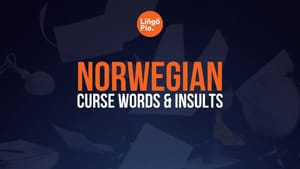You've probably heard Norwegian in movies or music and thought it sounded even more approachable than other European languages. And you’re actually right! In fact, the U.S. Foreign Service Institute ranks Norwegian as a Category I language, meaning it takes roughly 600 class hours for English speakers to reach proficiency. That puts it in the same league as Spanish and Italian for difficulty.
What nobody tells you is that those 600 hours can stretch into years of frustration if you approach Norwegian the wrong way. So in this post, let me share with you my personal tips and guide for learning Norwegian efficiently.
- Tandem Review: We Tested the App Everyone’s Comparing to Tinder
- Lingoda Review: Costly But Effective? Here’s the Truth!
- Mondly Review: Does Pearson’s AI-Powered App Live Up to the Hype?

How To Learn Norwegian Correctly
Norwegian offers several advantages for English speakers that most people don't realize. The shared Germanic roots, simplified grammar structure, and flexible pronunciation rules create natural learning shortcuts. When you work with these advantages rather than against them, progress accelerates significantly.
Step 1: Focus On Foundational Learning
Norwegian grammar is surprisingly easy to learn compared to other European languages. For instance, word order mirrors English in most cases: "Jeg er fra Norge" (I am from Norway) follows the same subject-verb-object pattern you already know.
The two Norwegian genders (en (masculine/feminine) and et (neuter)) also form the foundation of the language. About 75% of nouns use "en," so the odds are in your favor when guessing. These articles affect everything: adjectives, definite forms, and pronouns all change based on gender.
Additionally, Norwegian verbs don't change based on who’s doing the action, making them much simpler than other European languages. "Jeg snakker" (I speak) and "vi snakker" (we speak) use identical verb forms. This saves you hours compared to languages like Spanish or French, where every person requires different verb endings.
Similarly, frequency-based vocabulary gives you the biggest return on effort because the top 1,000 Norwegian words appear in 85% of everyday conversations. This approach beats memorizing random vocabulary from textbooks.

Step 2: Use Immersive Techniques
Once you have basic vocabulary, Norwegian media becomes your classroom. Children’s shows, Netflix shows, or simple YouTube channels work well because the repetitive language and visual context help you understand meaning without constantly checking dictionaries.
You can also change your phone’s language to Norwegian to create passive learning opportunities throughout your day. You already know where everything is, so the Norwegian labels become automatic associations between words and familiar functions.
For listening practice, Norwegian podcasts during commutes or walks help your ear adjust to Norwegian rhythm and pronunciation patterns, even when you understand only fragments. "Radioresepsjonen" offers casual conversation, while "Heartstone" provides simpler, clearer speech.
Another helpful strategy is setting Norwegian news as your homepage. This exposes you to current vocabulary that textbooks miss while helping you recognize patterns through daily headline reading. NRK and TV2 provide accessible starting points.
Step 3: Actively Use The Language
Speaking practice can't wait until you feel "ready." Norwegian pronunciation is forgiving because dialects vary so much that there's rarely one "correct" way to say something.
To get started, language exchange partners through HelloTalk or Tandem create perfect trading opportunities since many Norwegians want to practice English. Starting with 15-minute conversations about simple topics like weather, hobbies, and daily routines builds confidence gradually.
You should also practice internal monologue in Norwegian to build automatic response patterns as you describe daily activities. "Jeg lager kaffe" (I'm making coffee) or "Jeg går til butikken" (I'm going to the store) become natural thought processes over time.
Finally, short Norwegian journal entries force you to construct complete thoughts and reveal grammar gaps that passive listening misses. Three sentences about your day provides enough practice without overwhelming complexity.

Step 4: Be Consistent
Small, daily practice beats weekend marathon sessions because your brain consolidates language patterns during sleep. Daily exposure maintains momentum, so aim for 20-30 minutes daily rather than three-hour weekend sessions.
To track your progress, calendar tracking creates visual progress that maintains motivation during difficult periods when improvement feels slow. Mark each day you practice Norwegian to see consistency patterns develop over time.
I recommend mixing up your activities to prevent boredom while covering different skill areas throughout the week. Monday grammar review, Tuesday podcast listening, and Wednesday conversation practice keep your brain engaged across multiple learning channels.
Most importantly, micro-goals like "learn 10 new words this week" beat vague intentions like "get better at Norwegian" because specific targets let you measure progress and celebrate small wins.

Tips To Learn Norwegian Fast
Time pressure changes everything about language learning strategy. When you need Norwegian basics quickly—perhaps for an upcoming trip, job interview, or family visit—you can't afford to waste time on inefficient methods.
If you're on crunch time, be sure to try these tips!
Start With Norwegian Words Close To English
Cognates from Norwegian's Germanic roots require minimal memorization effort, making them perfect starting vocabulary. English and Norwegian share enough linguistic DNA that you already know hundreds of words without realizing it.
- For example, identical or near-identical words include: telefon (telephone), problem (problem), student (student), restaurant (restaurant), familie (family), and person (person).
- You'll also find slightly different spelling in words like: kaffe (coffee), ost (cheese—think "oast house"), fisk (fish), bok (book), hus (house), and drikke (drink).
Additionally, international words work everywhere: pizza, pasta, radio, video, computer, and internet.
Familiar words create the foundation for complete thoughts while your vocabulary expands naturally. For instance, "Jeg drikker kaffe i restauranten" uses three cognates and one simple verb to express a complete idea.
Focus On One Written Language
Bokmål dominates urban areas and represents about 85% of written Norwegian, making it the practical choice unless you have specific reasons for Nynorsk. The differences between forms are minor for beginners: "Jeg" (I) versus "eg," "ikke" (not) versus "ikkje," while grammar structures remain identical.
More importantly, consistent form usage prevents confusion in pattern recognition and accelerates progress. Mixing Bokmål and Nynorsk slows down learning, though you can always pick up the other form once comfortable with your chosen version.
Go For Basic Sentence Patterns
Master these four sentence patterns because they cover most daily communication needs:
- Subject + Verb: "Jeg kommer" (I'm coming)
- Subject + Verb + Object: "Jeg spiser fisk" (I eat fish)
- Subject + Verb + Adjective: "Hun er snill" (She is kind)
- Subject + Verb + Location: "Vi bor i Oslo" (We live in Oslo)
Pattern practice with different vocabulary builds fluency systematically. Once these become automatic, you can add complexity through time expressions, prepositions, and modal verbs. Foundation comes before decoration.
Similarly, Norwegian question formation mirrors English in most cases, making it intuitive for English speakers. "Hvor bor du?" (Where do you live?) simply switches the first two words from "Du bor hvor."
Use The Language As Much As You Can
Artificial Norwegian environments accelerate learning when natural exposure is limited. For example, changing your Netflix region to Norway and watching with Norwegian subtitles, ordering food using Norwegian phrases, or labeling household items with Norwegian names all create practice opportunities.
You should also join Norwegian Facebook groups or Reddit communities to expose yourself to natural language patterns through daily reading, even when comprehension is limited. Your understanding improves gradually through repeated exposure to authentic conversations.
For daily practice, Norwegian text reminders transform daily life into language practice without additional time investment. "Husk å kjøpe melk" (Remember to buy milk) or "Ring mamma i dag" (Call mom today) make Norwegian part of your routine.
Ready To Start Your Norwegian Journey?
Norwegian is within your reach, especially when you combine the right strategies with engaging content. The key is finding methods that keep you motivated while building real language skills progressively.
If you're excited about learning through Norwegian TV shows and movies, consider signing up for Lingopie's waitlist for Norwegian content. Our interactive approach to language learning through entertainment is simply guaranteed to make the process both effective and enjoyable.
Sign up for a free trial today to test how it works for other foreign languages!


![How To Learn Norwegian As A Beginner: Tips + Guide [2026]](/blog/content/images/size/w1200/2025/07/Learn-norwegian-as-a-beginner.jpg)



